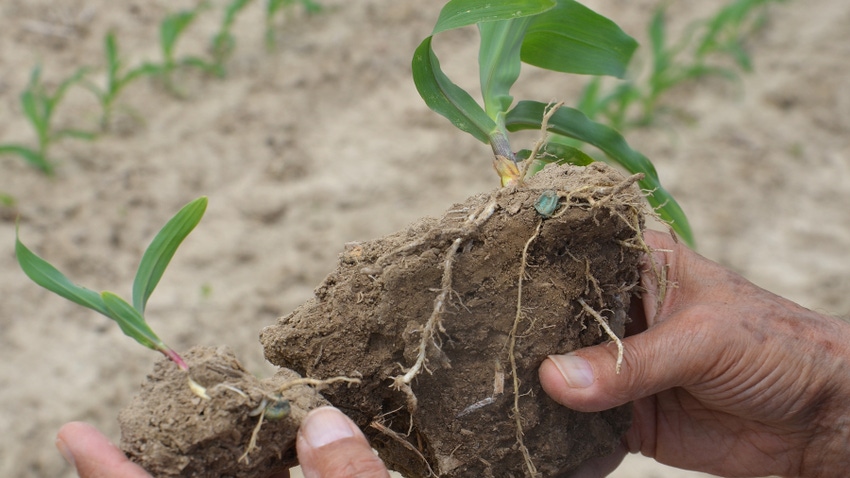
Dave Nanda suspected what was wrong with the two small plants in the picture right away. To confirm he was right, he pulled out his trowel and began digging.
“You can learn many things about corn and corn production management walking fields early in the season,” Nanda says. He should know — he has been walking fields since the early 1960s, as a plant breeder for many years and now as an adviser.
Nanda is director of plant genetics for Seed Genetics Direct, Jeffersonville, Ohio. Seed Genetics Direct sponsors Corn Watch ’23. By watching a field in the central part of the Corn Belt throughout the season, Nanda makes observations that could be helpful in your fields, no matter where you farm.
“These two guys caught my eye because they were smaller,” he says. “When you see something out of the ordinary, ask questions. In this case, they could have been growing slowly for various reasons, including soil compaction.”
Examine soil
When the soil lifted out in a large chunk, the answer was obvious to Nanda. Soil compaction was so intense where these plants were seeded that it impacted their ability to emerge on time. That’s likely why they were smaller than neighboring plants.
“Look carefully at how roots are growing,” Nanda says. “They’re trying to branch out and grow down, but it appears they’re following tiny cracks in the hard soil layers as they try to grow. Soil compaction limits rooting.”
When soil compaction forms in a hard layer, such as a plow pan, it may prohibit roots from growing downward so severely that they grow sideways instead. In extreme cases, plants later in the season may be easier to pull because most of their roots grew horizontally on top of the layer instead of penetrating to deeper depths. Because roots aren’t as deep as they should be, they won’t be successful in either anchoring the plant or pulling up as much water as the plant needs during hot, dry spells.
Diagnose and adjust
Why were two plants growing in very hard, compacted soil affected, while neighboring plants grew normally? That’s a trademark of soil compaction, Nanda explains. Soil composition and moisture level in the soil vary across a field, and wheel track patterns also vary, especially if you’re practicing conventional tillage. Some areas receive more wheel traffic from one pass or another than other areas.
The inconsistency in soil compaction across a field produces the “tall corn, short corn” effect, a term coined when Gary Steinhardt, a Purdue Extension soil specialist, first began diagnosing soil compaction and calling it out back in the early 1980s. Plants trying to grow where soils are more compacted often don’t get as tall as fast, producing the variation in crop size.
If you find plants like the two pictured here, the key is to determine what caused soil compaction, Nanda says. Was it traffic from the anhydrous ammonia application, tillage pass or planting pass? Were soils too wet?
“Figure out what adjustments you could make,” Nanda says. “It starts by walking fields, observing what is out of place, digging and investigating.”
About the Author(s)
You May Also Like




